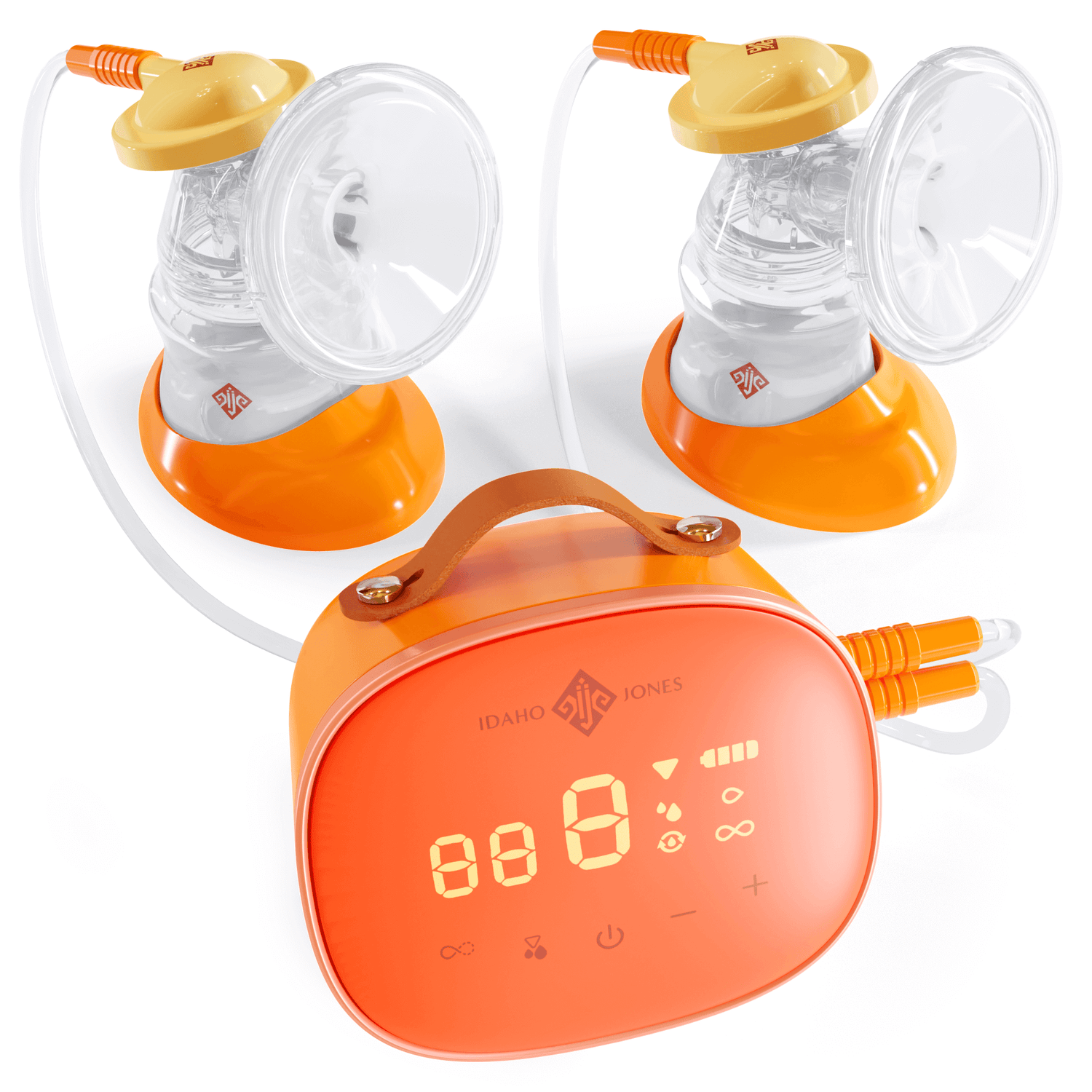
When Should You Go on Maternity Leave?
Share
Deciding when to start maternity leave is one of the most important choices you'll make as a new mom—especially if you plan to breastfeed, go back to work, and pump at work. The right timing can impact your physical recovery, mental health, milk supply, finances, and bonding time.
This blog post walks you through what the laws say, what your options are, and how to plan a timeline that works for you.
Understanding Your Rights: Federal Protections for Pregnant and New Moms
Family and Medical Leave Act (FMLA)
FMLA gives you up to 12 weeks of unpaid, job-protected leave for pregnancy, childbirth, and bonding with your baby. To be eligible, you must have:
- Worked 1,250 hours in the past year,
- Been employed for at least 12 months,
- Worked for a company with 50+ employees within 75 miles.
The PUMP Act
If you’re planning to pump at work, the PUMP for Nursing Mothers Act requires your employer to provide reasonable break time and a private space (not a bathroom) to pump for up to one year after your baby is born.
Pregnant Workers Fairness Act (PWFA)
PWFA requires employers with 15+ employees to offer reasonable accommodations during pregnancy and postpartum, like sitting more, lifting less, or working remotely.
Pregnancy Discrimination Act (PDA)
The PDA prohibits discrimination due to pregnancy, childbirth, or related conditions like lactation or miscarriage (EEOC).
Americans with Disabilities Act (ADA)
If a pregnancy results in complications that rise to the level of a disability, the ADA may provide protection and require accommodations (SHRM).
What Is Paid Medical Leave?
Paid medical leave is time off to recover from childbirth, surgery (like a C-section), or pregnancy complications. It’s typically:
-
6 weeks for vaginal delivery
8 weeks for a C-section - Longer if your doctor certifies complications
Many states offer paid medical leave as part of a short-term disability plan or family & medical leave program (Guardian Life).
Even if your state doesn’t offer paid parental leave, you may be able to get paid medical leave only — either through:
- A state disability program (e.g., California, New York)
- Your employer’s short-term disability insurance (if enrolled before pregnancy)
- Special opt-in programs (e.g., New Hampshire’s Paid Family & Medical Leave (PFML) for private employees) (NH PFML)
States That Provide Paid Parental Leave
Some states provide paid parental leave in addition to job protection. Below is a summary of the benefits for these states:
Note: Some states provide separate medical and bonding leave programs (e.g., CA, NY, MA), while others combine them into one total. Check your state's official resources for exact eligibility and benefit stacking options.
|
State |
Total Paid Leave Length |
How It Works |
Max Weekly Benefit ($) |
References |
|
California |
Up to 16 weeks |
8 wks bonding (PFL) + 6-8 wks medical (SDI) |
$1,620 |
|
|
Colorado |
12-16 weeks |
FAMLI provides both bonding & medical leave in one program |
$1,324 |
|
|
Connecticut |
12-14 weeks |
CTPL provides bonding & medical leave; can add 2 extra weeks for complications |
$981 |
|
|
Massachusetts |
Up to 26 weeks |
Up to 20 wks medical + 12 wks bonding under PFML |
$1,170 |
|
|
New Jersey |
Up to 20 weeks |
6-8 wks medical (TDI) + 12 wks bonding (FLI) |
$1,081 |
|
|
New York |
Up to 18 weeks |
6-8 wks medical (SDI) + 12 wks bonding (PFL) |
$1,177 |
|
|
Oregon |
Up to 14 weeks |
Paid Leave Oregon combines bonding & medical leave, plus 2 extra weeks for complications |
$1,568 |
|
|
Rhode Island |
Up to 30 weeks |
Up to 30 wks: 6-30 wks medical (TDI) + 6 wks bonding (TCI) |
$1,070 |
|
|
Washington |
Up to 18 weeks |
12 wks medical + 12 wks bonding under PFML, up to 18 total |
$1,542 |
|
|
Washington D.C. |
Up to 22 weeks |
2 wks prenatal + 12 wks medical + 8 wks bonding (some overlaps apply) |
$1,153 |
👉 More info: Rippling | Bipartisan Policy Center
States That Don’t Provide Parental Leave
Are there states that don’t have paid parental leave but do have paid medical leave for the birthing parent?
Yes — New Hampshire is a notable example.
New Hampshire
- Paid Parental Leave: ❌ Not offered
-
Paid Medical Leave: ✅ Yes, for state employees and private employers that opt in via the NH PFML program.
It covers up to 60% of wages for 6 weeks, including medical leave related to childbirth. - Source: NH Paid Family and Medical Leave Insurance
Other States with Partial/Opt-in Medical Leave:
Some states don’t offer statewide paid parental leave, but private short-term disability insurance (STD) is common and may be used for medical recovery after childbirth. These include:
- Texas
- Florida
- Georgia
- Most other states without formal state PFML laws
In these states:
- Medical leave is often through employer-provided STD plans.
- Birthing parents may receive 6–8 weeks of partial pay if they enrolled in STD before becoming pregnant.
👉 Bottom line: In states with no state-mandated leave, short-term disability is often the only route to paid medical leave for birthing moms.
If You’re Eligible for Both FMLA and State Paid Leave
You get the best of both worlds — job protection from FMLA and income replacement from your state program. Here's how it typically works:
FMLA = Job Protection (Unpaid)
- Guarantees you can return to your same (or equivalent) job.
-
Provides 12 weeks of unpaid leave, which can be used for:
- Medical recovery (e.g., after childbirth)
- Bonding with your baby
- Federal law (applies nationwide)
State Paid Leave = Income While You’re Out
- Offers partial wage replacement during your leave.
-
Can include:
- Medical leave (for pregnancy, childbirth, or complications)
- Parental leave (for bonding with baby)
- Available only in the states listed above
How They Work Together
They often run concurrently — meaning your time off counts against both. For example:
- You take 6 weeks of bonding leave.
- That counts as 6 weeks of FMLA and 6 weeks of paid family leave.
- You’re getting paid, and your job is protected.
Some states (like Massachusetts or Washington) automatically apply both FMLA and state benefits simultaneously. Others require separate applications — one with your employer (FMLA), one with the state.
Important Tips
-
Apply for both: You typically have to file separate paperwork for FMLA (through HR) and state benefits (through the state agency).
-
Ask your HR team: They should help coordinate how the two types of leave work together.
- Double-check your timeline: FMLA provides up to 12 weeks, but your state may offer more or less. Some states offer extra time for medical complications.
What happens to parents not covered under FMLA?
This is a common scenario, especially for:
- Employees at companies with fewer than 50 employees
- Parents who’ve been at their job less than 12 months
- Part-time workers who haven’t hit 1,250 hours in the past year
If you don’t qualify for FMLA:
You don’t get federal job protection, which means:
-
Your employer is not legally required to hold your job.
You may still qualify for state-level job protection, paid leave, or employer-provided leave, depending on your state and employer policies.
What you can do :
-
Ask your employer for voluntary job protection:
- Many small businesses are willing to grant leave if asked.
- Get any agreements in writing.
- Leverage state programs (if available):
- Many state leave programs don’t require FMLA eligibility.
- For example: California PFL, New York PFL, Massachusetts PFML — all offer paid leave with job protection regardless of FMLA status.
- Apply for accommodations under the Pregnant Workers Fairness Act (PWFA):
- You can request light duty, work-from-home, or a flexible schedule, even if you’re not covered by FMLA.
- Applies to employers with 15+ employees.
- More on PWFA here
Maternity Leave Benefits Decision Tree

Planning Your Maternity Leave Timeline
Parental leave consultants (like Hello Bundle) recommend telling your employer about your plans at least 8 weeks before your due date. That means you’ll want to start prepping around 20–24 weeks pregnant.
Here’s a sample timeline:
|
Week of Pregnancy |
What to Do |
|
20–24 weeks (5–6 months) |
Research your state and employer benefits. Contact HR. |
|
24–28 weeks |
Confirm due date and intended leave date. Decide when to start leave (before or at birth). |
|
28–30 weeks |
Talk to your doctor about any physical concerns. If needed, ask about early medical leave. |
|
30–32 weeks |
Formally notify your employer. Put your leave plans in writing. |
|
32–36 weeks |
Submit paperwork for FMLA, short-term disability, or state leave. |
|
36–38 weeks |
If you’re planning to begin leave before birth, this is a common window. Otherwise, keep working until labor starts. |
|
Postpartum |
Submit medical documentation and apply for bonding leave (if separate). Confirm pay start dates. |
How to Decide When to Go on Leave
There’s no perfect answer. The best timing depends on your health, job type, financial cushion, and personal preferences. Here are some questions to ask:
- Do I have a high-risk pregnancy or need bed rest?
- Is my job physically demanding or high stress?
- How much paid vs unpaid leave can I afford?
- Do I want time to nest and rest before baby arrives?
- Am I eligible for job protection and paid time off?
Many moms plan to stop working around 36–38 weeks, while others work right up to labor to maximize their bonding time postpartum. Some use PTO to bridge days before benefits begin.
Preparing for maternity leave can feel overwhelming—but having a plan makes all the difference. Knowing your rights, exploring your options, and communicating early with your employer helps you take the leave you need and deserve. Whether you're working until the day you deliver or stepping away a few weeks before, trust that you're making the best decision for yourself and your baby. Every mom’s journey is different—and you’re doing it right. 💛
References
Davis, Linzay. The Ultimate Parental Leave Guide. Hello, Bundle, 2025.
“Disability Insurance for Pregnancy.” Guardian Life. https://www.guardianlife.com/disability-insurance/pregnancy
EEOC. Pregnancy Discrimination Act of 1978. https://www.eeoc.gov/statutes/pregnancy-discrimination-act-1978
Employee not Eligible for FMLA, Criterion HMC, https://www.criterionhcm.com/blog/employee-not-eligible-for-fmla
“Family and Medical Leave Act (FMLA).” U.S. Department of Labor. https://www.dol.gov/agencies/whd/fact-sheets/28-fmla
“Is Pregnancy Covered by the Americans with Disabilities Act?” SHRM. https://www.shrm.org/topics-tools/tools/hr-answers/pregnancy-covered-americans-disabilities-act
Paid Maternity Leave by State. Rippling. https://www.rippling.com/blog/paid-maternity-leave-by-state
Paid Family and Medical Leave Insurance. New Hampshire Department of Administrative Services, 2025. https://www.nh.gov/pfml/
“State Paid Family Leave Laws Across the U.S.” Bipartisan Policy Center, 2023. https://bipartisanpolicy.org/explainer/state-paid-family-leave-laws-across-the-u-s/
“What You Should Know About the Pregnant Workers Fairness Act.” U.S. Equal Employment Opportunity Commission. https://www.eeoc.gov/wysk/what-you-should-know-about-pregnant-workers-fairness-act
“Break Time for Nursing Mothers Under the FLSA.” U.S. Department of Labor. https://www.dol.gov/agencies/whd/pump-at-work

